"We're Still Here": Chicago's Native American Community
Daniel Hautzinger
November 8, 2018
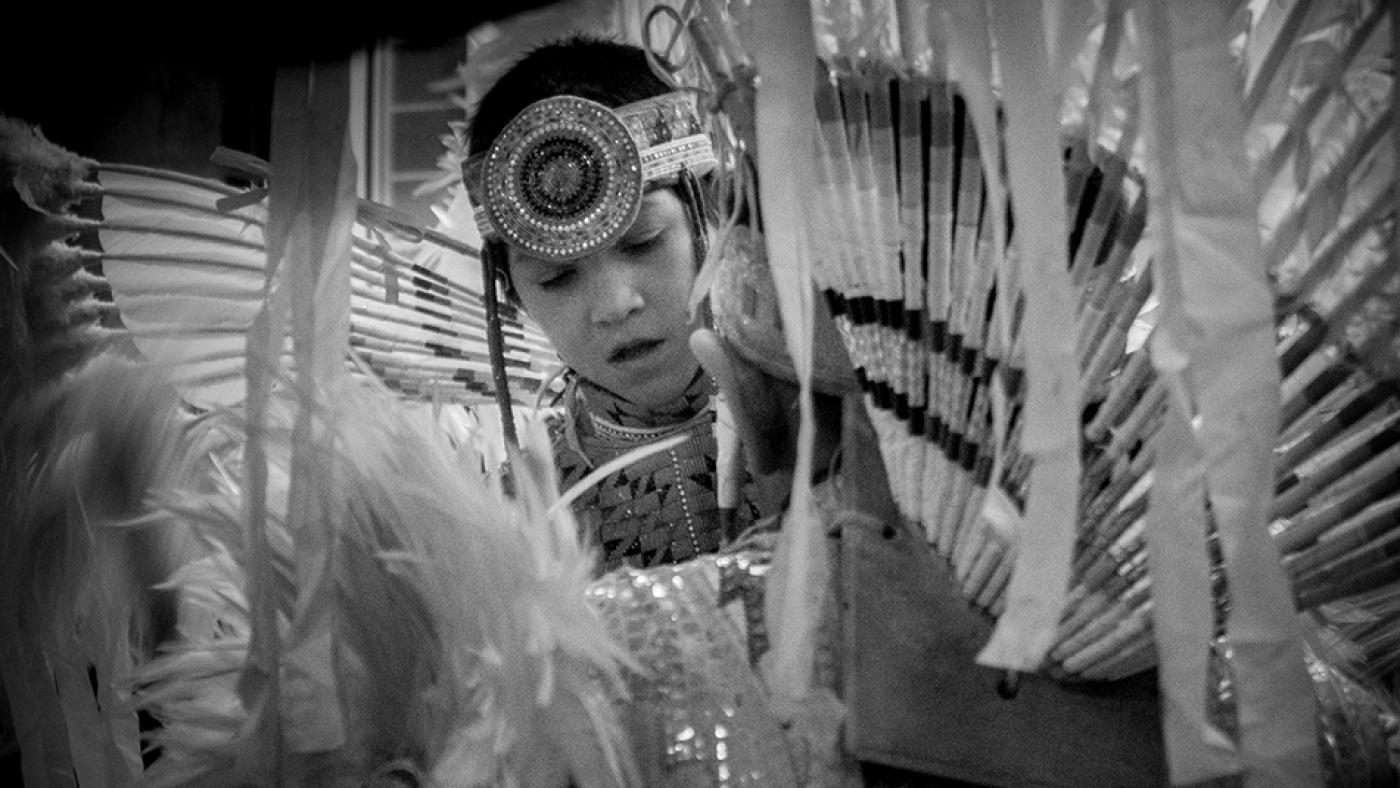
Native America is available to stream by Passport members.
Traces are all around, but it is often obscured or even forgotten that Chicago is built on land that was home to various Native American tribes for hundreds of years. Local members of the Miami tribe demonstrated the value of the swampy area to Europeans when they showed the French explorers Jacques Marquette and Louis Jolliet a portage between the Chicago River and Illinois and Des Plaines Rivers. The city’s name comes from the Algonquian people, who called the river on which it sits “Checagou” after the stinky wild leeks that grew along its shore. One of the first permanent settlers of the area was a Potawatomi woman named Kittahawa, who ensured the trading success of her husband, Jean Baptiste Point DuSable, by acting as a liaison and translator to her fellow Native Americans. Métis, the mixed-race children of Native American and European parents, helped the spot flourish as a hub of interactions between European traders and Native American trappers. Native American trails became integral roads for settlers as the city grew: Ridge Avenue, Ogden Avenue, Vincennes Avenue, parts of Grand Avenue.
(Learn more about the history of Native Americans in Chicago and the origins of place names and street paths in this "Ask Geoffrey" segment from Chicago Tonight.)
And then Native Americans were almost entirely removed from the region through bloody conflicts and unfair treaties that ceded their land to Europeans. As a result of the Black Hawk War of 1832 and the 1833 Treaty of Chicago, most remaining Native Americans were forced out of the area around Chicago.
 Photo: American Indian Center
Photo: American Indian Center
“For time immemorial, tribes from across the country congregated here in the Chicago area; it was a central trade hub,” says Heather Miller, the executive director of the American Indian Center in Chicago and a member of the Wyandotte Nation of Oklahoma. “Oftentimes we forget about that important history, and it’s so often overlooked from the history of Chicago.”
After the removal of Native Americans from the region, Chicago did not have a significant Native presence for over a hundred years. But in the 1950s, the federal government enacted a new policy to address what it saw as the Indian problem – one in a long line of disastrous and discriminatory policies that have removed Native Americans from their land, led to high rates of poverty, and otherwise disadvantaged and disenfranchised them. The Indian Relocation Act of 1956 sought to disperse Native Americans into cities from their reservations by ending federal recognition of many tribes and discontinuing federal funding for many of the reservations’ services, such as schools and hospitals. While the government paid to relocate Native Americans and provided some vocational training, many Native Americans struggled to find work and adapt to an urban lifestyle upon arriving in cities. And that’s why the American Indian Center was founded: to provide both social services and a gathering place for people faced with a drastic and overwhelming life change.
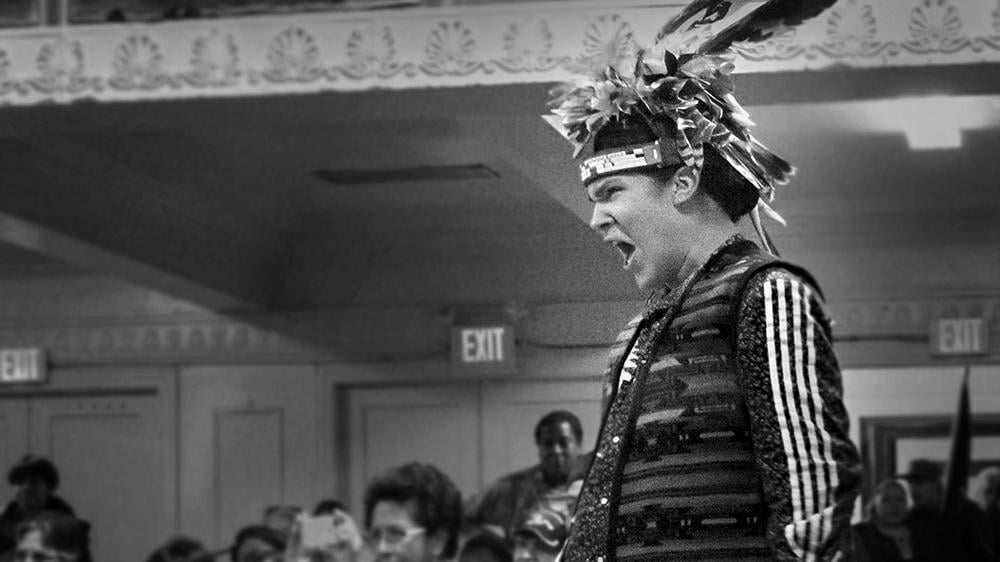 Photo: Warren Perlstein, courtesy American Indian Center
Photo: Warren Perlstein, courtesy American Indian Center
“With relocation, Native folks on reservations were given a bus ticket and told, ‘Here are a list of cities you can go to – they’ll have a lot of opportunities for you,’ “ Miller explains. “Natives start arriving in these cities and find that there isn’t this breadth of opportunity that was promised them. They start coming to brand-new places that they have no experience with. They don’t necessarily speak English very well, they’ve never seen these big buildings before, some don’t even know how electricity works.
“Chicago was one of those relocation cities, so quite a few Native folks from all across the country ended up here. Our older folks came together and said, ‘We need our own place, we need a gathering spot for connecting Natives who are coming to the city. We can provide them with resources, with education, and just be a place where everyone can come and hang out. So the Indian Center was born.”
Chicago today has the third-largest urban Indian population in the United States, with more than 65,000 Native Americans in the greater metropolitan area and some 175 different tribes represented. The American Indian Center, founded in 1953, is the oldest urban Indian center in the country. For decades, it was located in a former Masonic lodge on Wilson Avenue in Uptown, near where many Native Americans settled when they first came to Chicago. (“Uptown had the nickname ‘Hillbilly Heaven and Redskin Row,’ because this particular area of it was populated by poor white people and Indians,” Miller says.) Last year the AIC sold that building and moved to a new location in Albany Park, close to the intersection of Kimball and Lawrence Avenues.
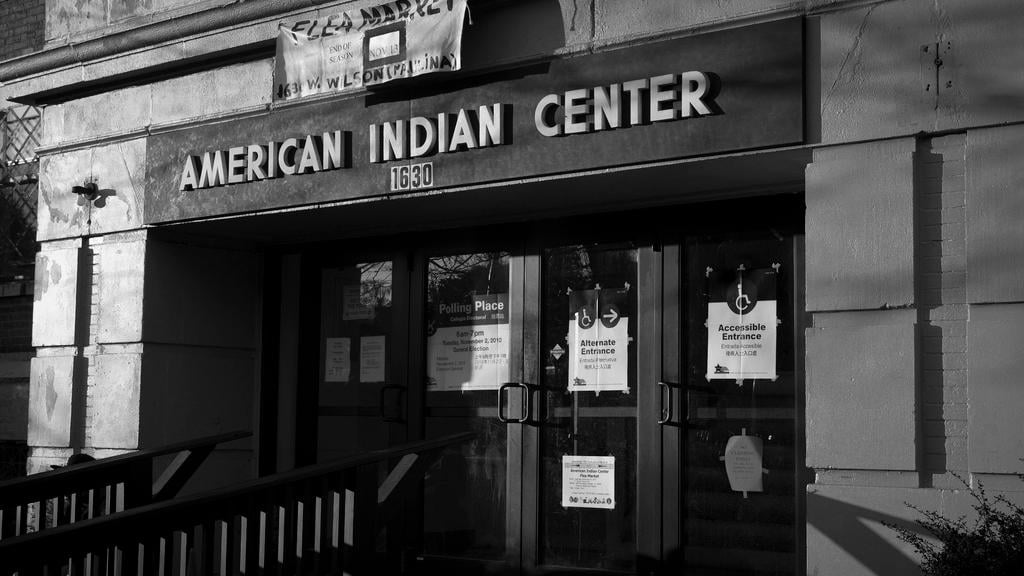 The previous location of the American Indian Center, on Wilson Avenue
The previous location of the American Indian Center, on Wilson Avenue
While the AIC originally offered social services in addition to cultural and educational programming, in recent years it has scaled back that aspect of its mission, Miller says. “There have now been a couple generations of Native folk here in Chicago. They’ve established themselves and they’ve stepped away from needing a lot of that social service aspect. But we still need a place to gather and to practice our traditions and our heritage.”
Because the AIC supports so many different tribes, celebrating all those traditions can be a bit tricky – but also rewarding. “Imagine having a family of 175 different people, and what that dining room table at Thanksgiving is like,” Miller says, laughing. “Nobody’s going to want to eat the same turkey, there are going to be 30 different potato dishes, everyone will have different opinions.” So the AIC focuses its educational efforts, such as an after-school program and land-based education involving community gardens, on common themes instead of specific tribal traditions.
“Something that is very true to many of our communities is how we take care of and interact with the land and with plants and animals,” Miller explains. “We have plants – like sweetgrass, sage, tobacco, and cedar – that pretty much all of us use for ceremonies, for medicine, and for different ways of being Native.” The AIC has small garden plots in which they grow some of those plants, and they recently acquired a city lot at Pulaski Road and Wilson Avenue to provide more opportunities for community gardening and land-based education.
 Photo: American Indian Center
Photo: American Indian Center
The AIC also organizes events that allow tribes to share their distinct traditions with each other, such as a recent social dance. “It was so cool, because we got to share these pieces of our own heritage and history and learn more about what makes each one of us unique,” Miller says. There is also an annual powwow, a gathering that includes dances and competitions.
Nor has the AIC completely dropped its social service aspect. It provides support and resources to Native people who have been trafficked with its Project Beacon, through partnership with homeless shelters, domestic violence shelters, drug counselling centers, and places that provide employment opportunities, among other organizations.
This year the AIC received funding from the National Urban Indian Family Coalition for get-out-the-vote efforts in an election that saw allegations of discrimination against Native Americans in North Dakota by means of voting laws but also the election of the country’s first two female Native American congresswomen. The AIC also served as a polling place and hosted a party to watch the returns from Illinois and for the record number of Native candidates across the country.
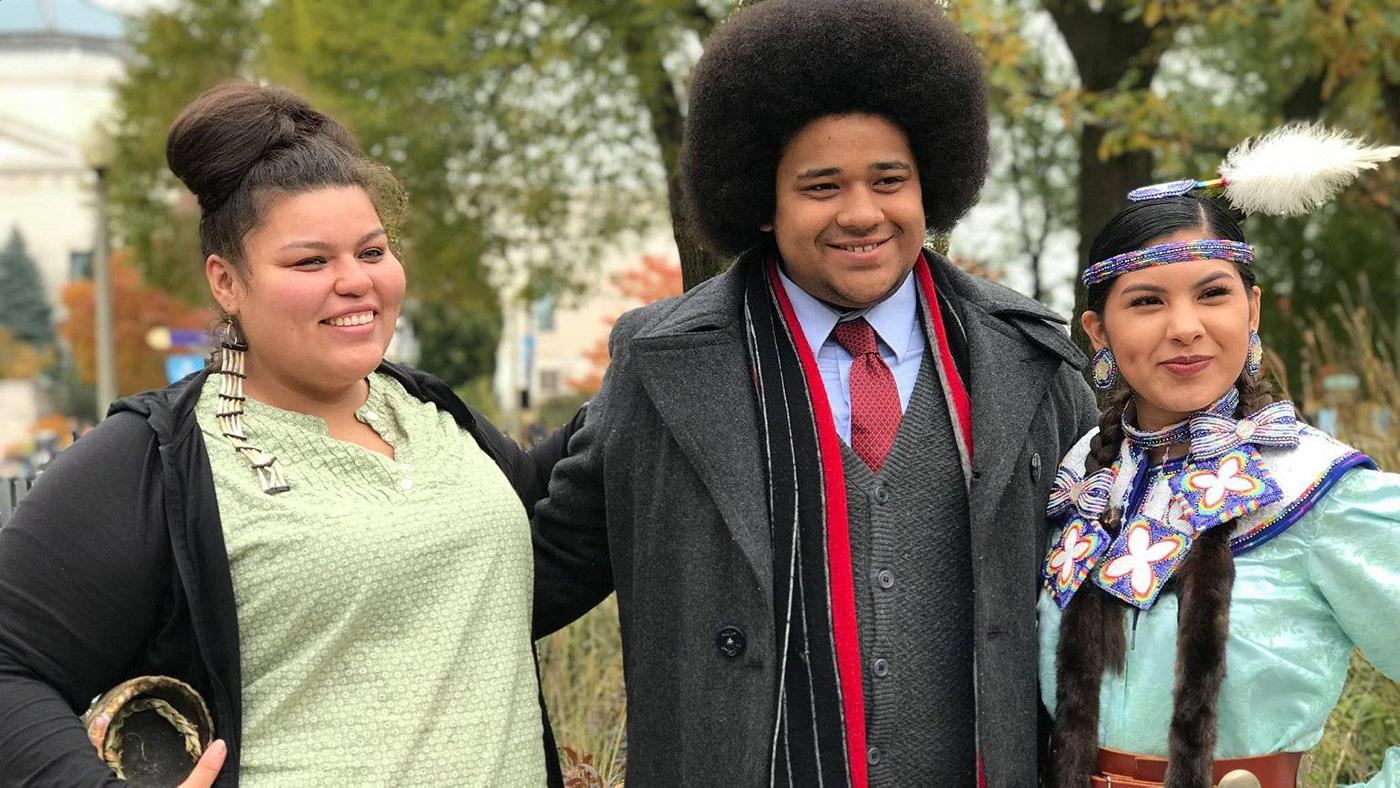 Members of several Native American tribes attended a land acknowledgement ceremony at the Field Museum on Oct. 26, 2018. Photo: The Field Museum
Members of several Native American tribes attended a land acknowledgement ceremony at the Field Museum on Oct. 26, 2018. Photo: The Field Museum
Two ongoing projects expand the AIC’s educational outreach to non-Native peoples. The Field Museum recently announced that it has partnered with the AIC to renovate the Museum’s Native North American Hall in order to better represent the Native peoples of the region. (Watch Miller discuss the renovation on Chicago Tonight with the Field Museum’s Anthropology Curator, Alaka Wali.) The Museum also held a land acknowledgment ceremony to recognize that it stands on the traditional homeland of the Ojibwe, Odawa, and Potawatomi tribes.
Farther north, for the Northwest Portage Walking Museum, which will cover an eleven-mile stretch of Irving Park Road between the Chicago River and the Des Plaines River, the AIC has partnered with the Portage Park Neighborhood Association and the Chicago Public Art Group. “We’re trying to figure out ways to connect all the communities that have called that area home over the centuries, in a way that presents their history in a positive public art space,” Miller says.
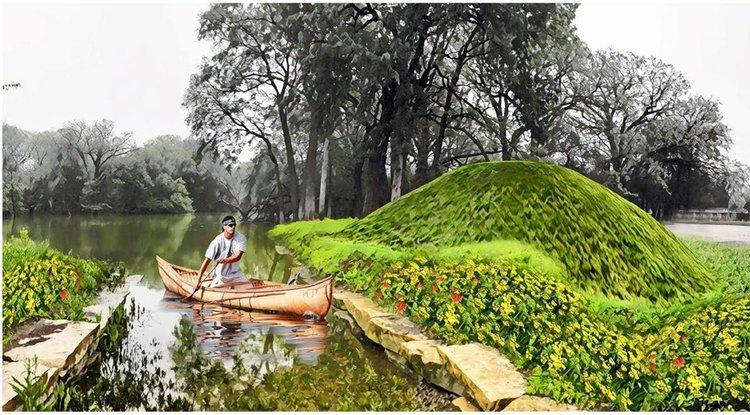 A rendering of a proposed Serpent Mound for Schiller Woods on the Des Plaines River as part of the Northwest Portage Walking Museum. Image: American Indian Center
A rendering of a proposed Serpent Mound for Schiller Woods on the Des Plaines River as part of the Northwest Portage Walking Museum. Image: American Indian Center
The two ends of the Walking Museum, at Horner Park and Schiller Woods, will be marked by two contemporary mounds designed by the Native artist Santiago x and built with the help of volunteers. “The tribes that called this area home were mound builders,” Miller explains. “They used them as wayfinding tools or to honor spirits and family members. We wanted to bring that part of their history back and celebrate it.” The hope is to eventually partner with other communities between the two sites to create a Walking Museum trail that connects all the communities in the area.
“The mounds will provide education to the greater community and remind folks that we’re still here; the Native community hasn’t gone away,” Miller says. “We’re still very much connected to this land and to our history, and you can come to the AIC to learn more about it. Oftentimes, it’s easy to forget that Native people have a presence here in Chicago, but we’re living, we’re thriving, and we do really awesome stuff. We don’t keep it to ourselves, and we love having people come and participate with us and learn more about us when we have events or opportunities to share our culture.”







